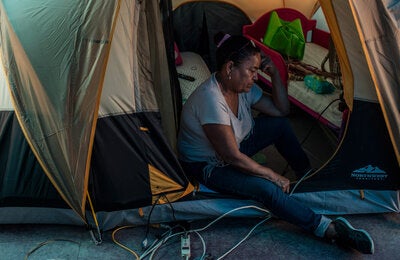PAHO/WHO official calls for major scale-up of response efforts
Washington D.C., 2 December 2010 (PAHO) — The number of cholera cases continues to grow in Haiti, but a smaller proportion of people who become ill are now dying from the disease, according to data released this week.
In the first weeks of the cholera epidemic, which began in late October, the proportion of hospitalized patients dying of cholera was as high as 9 percent. In the latest reports from Haiti's Ministry of Health, that figure is down to 3.5 percent.
"This is progress," said Dr. Jon K. Andrus, Deputy Director of the Pan American Health Organization/World Health Organization (PAHO/WHO). "There are still too many deaths, and we face many challenges. But the hard work of Haitian doctors, nurses, and community workers and their partners in the international community is, in fact, saving many lives."
The data released this week show that, since late October, cholera has killed more than 1,800 people and has sickened at least 80,000 in all 10 of Haiti's departments. Andrus and other public health experts believe, however, that these numbers significantly underestimate the true toll of the epidemic because of gaps in case reporting.
Epidemiological modeling carried out by PAHO/WHO and the U.S. Centers for Disease Control and Prevention (CDC) for planning purposes projects an estimated 400,000 cases over the first 12 months, with as many as half those cases occurring in the first three months of the epidemic.
Andrus said this means efforts need to be scaled up, since "cholera is now entrenched in Haiti, and conditions on the ground are such that we should expect many more cases."
"The main challenge we face in Haiti today is scaling up the response over the next few weeks, particularly as we approach the holiday season when it will become more difficult to mobilize outside support, supplies, and other resources," he said.
Scale-up plans developed by Haiti's Ministry of Health with support from PAHO/WHO and other U.N. agencies propose an increase in the number of cholera treatment centers and expanded efforts to promote prevention and treatment at the family and community levels through public education and by providing chlorination tablets and oral rehydration salts.
This work alone will require an additional 350 doctors, 2,000 nurses, and 2,200 support staff over the next three months, training for some 30,000 community health workers and volunteers, and additional supplies of oral rehydration salts and water purification tablets. Andrus noted that these requirements could change as the situation continues to evolve.
Other pressing needs include more intravenous rehydration solution, antibiotics, chlorine, body bags, personal protective equipment, water bladders and cisterns, cholera beds, and materials for constructing latrines.
The impact of cholera in Haiti has been particularly severe, Andrus and other experts say, because large sectors of the population have poor access to clean water and sanitation, because Haitians had not been previously exposed to the disease and therefore lacked natural immunity to it, and because of difficulties in getting patients to health facilities in time for effective treatment.
"We know that many patients were arriving too late at hospitals and health clinics. Expanding the number of treatment facilities and educating people about the need for early treatment have helped reduce the proportion of deaths," Andrus said. "In the midst of this outbreak, people need to know that with the very first loose stool they need to start taking oral rehydration salts. If they do that, we can save more lives."
PAHO/WHO and other international partners have been supporting the Haitian Ministry of Health in efforts to educate the public on preventing and coping with cholera and in efforts to improve hygiene in resettlement camps, homes and public places such as markets, schools, healthcare facilities, and prisons. To scale up these efforts, PAHO/WHO has proposed the immediate recruitment of 1,000 community environmental workers.



